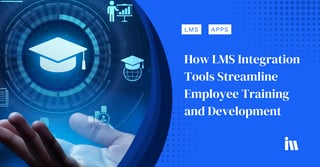How LMS Integration Tools Streamline Employee Training and Development

In today's fast-paced work environment, organizations are under pressure to ensure their workforce stays skilled, adaptable, and productive. A well-structured training program is essential, but it can quickly become overwhelming without the right technology to manage it. That’s where LMS integration tools come in. By seamlessly connecting learning management systems with other digital platforms, businesses can streamline employee training and development, improve tracking, and create more efficient workflows.
What Is LMS Integration?
LMS integration refers to the process of connecting a learning management system with other enterprise software systems, such as human resource management systems (HRMS), customer relationship management (CRM) tools, communication platforms, and data analytics solutions. These integrations ensure that all tools work in harmony, eliminating data silos and manual processes.
For example, integrating your LMS with an HR system allows automatic syncing of employee information, such as job roles, department, and training requirements. Similarly, syncing with calendar and communication tools like Microsoft Outlook or Slack enables automated reminders and learning notifications.
Why LMS Integration Tools Matter
A robust LMS integration tool allows organizations to go beyond basic content delivery. It supports the automation of repetitive tasks such as assigning courses, tracking progress, and reporting. This not only saves time for administrators but also ensures a smoother learning experience for employees.
Instead of manually tracking each individual’s progress, an integrated LMS can pull data from various systems to keep real-time tabs on training completion, performance metrics, and skill gaps. This visibility is crucial for HR teams and managers to evaluate employee readiness and identify areas for development.
Centralized Data and Reporting
One of the most powerful benefits of using an LMS integration tool is centralized data access. When your LMS is integrated with other platforms, data flows freely and automatically. This means training outcomes, performance assessments, and compliance records are stored in one place, making it easy to generate detailed reports.
Moreover, this centralized reporting supports compliance with industry regulations by serving as a reliable employee training tracker. With audit trails and clear documentation, organizations can quickly provide evidence of employee certifications and completed training when required.
Personalized and Adaptive Learning
Integrated systems can also deliver personalized learning experiences. When your LMS integration pulls data from performance reviews or skill assessments, it can tailor training pathways to each employee’s needs. This ensures that employees receive relevant, engaging content that supports their individual growth and role-specific requirements.
Enhancing Productivity and Engagement
The automation and personalization offered by LMS integration tools directly impact employee engagement and productivity. Learners no longer have to navigate multiple platforms or repeat training due to poor record-keeping. Instead, they can focus on gaining knowledge that helps them perform better in their roles.
Additionally, trainers and managers can spend more time mentoring and less time managing logistics, ultimately enhancing the overall quality of the training program.
Conclusion
Incorporating LMS integration into your training strategy is no longer optional—it’s essential for businesses aiming to stay competitive and agile. With the right LMS integration tool, you can automate processes, centralize training data, deliver personalized learning, and maintain a reliable employee training tracker. The result? A smarter, more efficient approach to employee training and development that drives real results.
